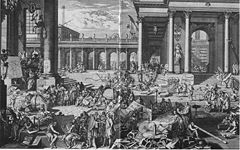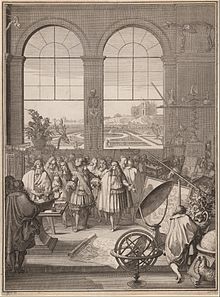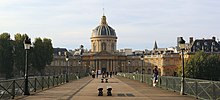French Academy of Sciences: Difference between revisions
→List of members of French Academy of Sciences: added link |
Rescuing 4 sources and tagging 0 as dead. #IABot (v1.5.5) |
||
| Line 53: | Line 53: | ||
* the [[Richard Lounsbery Award]], jointly with the [[United States National Academy of Sciences|National Academy of Sciences]] |
* the [[Richard Lounsbery Award]], jointly with the [[United States National Academy of Sciences|National Academy of Sciences]] |
||
* the Prix [[Jacques Herbrand]] – for mathematics and physics |
* the Prix [[Jacques Herbrand]] – for mathematics and physics |
||
* the [[Louis Bachelier Prize]] for major contributions to mathematical modeling in finance <ref>http://www.academie-sciences.fr/activite/prix/gp_natixis.htm</ref> |
* the [[Louis Bachelier Prize]] for major contributions to mathematical modeling in finance <ref>{{cite web |url=http://www.academie-sciences.fr/activite/prix/gp_natixis.htm |title=Archived copy |accessdate=2014-08-13 |deadurl=yes |archiveurl=https://web.archive.org/web/20141026191221/http://www.academie-sciences.fr/activite/prix/gp_natixis.htm |archivedate=26 October 2014 |df=dmy-all }}</ref> |
||
* the Prix Michel Mon{{color|#808080|t}}petit for computer science and applied mathematics, awarded since 1977<ref>[[:fr:Prix Monpetit|French wikipedia article]]; both "[http://www.academie-sciences.fr/activite/prix/laureats_prixthem2011.pdf Monpetit] {{webarchive |url=https://web.archive.org/web/20110902033652/http://www.academie-sciences.fr/activite/prix/laureats_prixthem2011.pdf |date=2 September 2011 }}" and "[http://www.academie-sciences.fr/activite/prix/laureat_montpetit.pdf Mon'''t'''petit] {{webarchive |url=https://web.archive.org/web/20150114130029/http://www.academie-sciences.fr/activite/prix/laureat_montpetit.pdf |date=14 January 2015 }}" is found in Academy publications.</ref> |
* the Prix Michel Mon{{color|#808080|t}}petit for computer science and applied mathematics, awarded since 1977<ref>[[:fr:Prix Monpetit|French wikipedia article]]; both "[http://www.academie-sciences.fr/activite/prix/laureats_prixthem2011.pdf Monpetit] {{webarchive |url=https://web.archive.org/web/20110902033652/http://www.academie-sciences.fr/activite/prix/laureats_prixthem2011.pdf |date=2 September 2011 }}" and "[http://www.academie-sciences.fr/activite/prix/laureat_montpetit.pdf Mon'''t'''petit] {{webarchive |url=https://web.archive.org/web/20150114130029/http://www.academie-sciences.fr/activite/prix/laureat_montpetit.pdf |date=14 January 2015 }}" is found in Academy publications.</ref> |
||
* the [[Leconte Prize]], awarded annually since 1886, to recognize important discoveries in mathematics, physics, chemistry, natural history or medicine |
* the [[Leconte Prize]], awarded annually since 1886, to recognize important discoveries in mathematics, physics, chemistry, natural history or medicine |
||
| Line 64: | Line 64: | ||
=== Presidents === |
=== Presidents === |
||
Source: [http://www.academie-sciences.fr/academie/membre/liste_president.htm French Academy of Sciences] |
Source: [https://web.archive.org/web/20141112092133/http://www.academie-sciences.fr/academie/membre/liste_president.htm French Academy of Sciences] |
||
{{columns-list|3| |
{{columns-list|3| |
||
*1800 [[Napoleon Bonaparte]] |
*1800 [[Napoleon Bonaparte]] |
||
| Line 74: | Line 74: | ||
*2007–2008 [[Jules Hoffmann]] |
*2007–2008 [[Jules Hoffmann]] |
||
*2009–2010 [[Jean Salençon]] |
*2009–2010 [[Jean Salençon]] |
||
*2011-2012 [[Alain Carpentier]] <ref>http://www.academie-sciences.fr/academie/membre/liste_president.htm</ref> |
*2011-2012 [[Alain Carpentier]] <ref>{{cite web |url=http://www.academie-sciences.fr/academie/membre/liste_president.htm |title=Archived copy |accessdate=2015-02-12 |deadurl=yes |archiveurl=https://web.archive.org/web/20141112092133/http://www.academie-sciences.fr/academie/membre/liste_president.htm |archivedate=12 November 2014 |df=dmy-all }}</ref> |
||
*2013–2014 [[Philippe Taquet]] |
*2013–2014 [[Philippe Taquet]] |
||
*2015-2016 [[Bernard Meunier]] |
*2015-2016 [[Bernard Meunier]] |
||
| Line 1,705: | Line 1,705: | ||
* {{Official website|http://www.academie-sciences.fr}} {{fr icon}} – [http://www.academie-sciences.fr/en English-language version] |
* {{Official website|http://www.academie-sciences.fr}} {{fr icon}} – [http://www.academie-sciences.fr/en English-language version] |
||
* [http://www.academie-sciences.fr/academie/membre.htm Complete listing of current members] |
* [http://www.academie-sciences.fr/academie/membre.htm Complete listing of current members] |
||
* [http://www.scholarly-societies.org/history/1666as.html Notes on the Académie des Sciences from the Scholarly Societies project] (includes information on the society journals) |
* [https://web.archive.org/web/20060425224502/http://www.scholarly-societies.org/history/1666as.html Notes on the Académie des Sciences from the Scholarly Societies project] (includes information on the society journals) |
||
* [http://gallica.bnf.fr Search the Proceedings of the Académie des sciences in the French National Library (search item: Comptes Rendus)] |
* [http://gallica.bnf.fr Search the Proceedings of the Académie des sciences in the French National Library (search item: Comptes Rendus)] |
||
* [http://gallica.bnf.fr/ark:/12148/cb34394200t/date ''Comptes rendus de l'Académie des sciences. Série 1, Mathématique''] in [[Gallica]], the digital library of the [[BnF]]. |
* [http://gallica.bnf.fr/ark:/12148/cb34394200t/date ''Comptes rendus de l'Académie des sciences. Série 1, Mathématique''] in [[Gallica]], the digital library of the [[BnF]]. |
||
Revision as of 20:48, 7 October 2017
This article needs additional citations for verification. (February 2013) |

The French Academy of Sciences (French: Académie des sciences) is a learned society, founded in 1666 by Louis XIV at the suggestion of Jean-Baptiste Colbert, to encourage and protect the spirit of French scientific research. It was at the forefront of scientific developments in Europe in the 17th and 18th centuries, and is one of the earliest Academies of Sciences.
Currently headed by Sébastien Candel (President of the Academy), it is one of the five Academies of the Institut de France.
History

The Academy of Sciences traces its origin to Colbert's plan to create a general academy. He chose a small group of scholars who met on 22 December 1666 in the King's library, and thereafter held twice-weekly working meetings there. The first 30 years of the Academy's existence were relatively informal, since no statutes had as yet been laid down for the institution. In contrast to its British counterpart, the Academy was founded as an organ of government. The Academy was expected to remain apolitical, and to avoid discussion of religious and social issues (Conner, 2005, p. 385).

On 20 January 1699, Louis XIV gave the Company its first rules. The Academy received the name of Royal Academy of Sciences and was installed in the Louvre in Paris. Following this reform, the Academy began publishing a volume each year with information on all the work done by its members and obituaries for members who had died. This reform also codified the method by which members of the Academy could receive pensions for their work.[1] On 8 August 1793, the National Convention abolished all the academies. On 22 August 1795, a National Institute of Sciences and Arts was put in place, bringing together the old academies of the sciences, literature and arts, among them the Académie française and the Académie des sciences. Almost all the old members of the previously abolished Académie were formally re-elected and retook their ancient seats. Among the exceptions was Dominique, comte de Cassini, who refused to take his seat. Membership in the Academy was not restricted to scientists: in 1798 Napoleon Bonaparte was elected a member of the Academy and three years later a president in connection with his Egyptian expedition, which had a scientific component.[2] In 1816, the again renamed "Royal Academy of Sciences" became autonomous, while forming part of the Institute of France; the head of State became its patron. In the Second Republic, the name returned to Académie des sciences. During this period, the Academy was funded by and accountable to the Ministry of Public Instruction.[3] The Academy came to control French patent laws in the course of the eighteenth century, acting as the liaison of artisans' knowledge to the public domain. As a result, academicians dominated technological activities in France (Conner, 2005, p. 385). The Academy proceedings were published under the name Comptes rendus de l'Académie des sciences (1835–1965). The Comptes rendus is now a journal series with seven titles. The publications can be found on site of the French National Library.
In 1818 the French Academy of Sciences launched a competition to explain the properties of light. The civil engineer Augustin-Jean Fresnel entered this competition by submitting a new wave theory of light.[4] Siméon Denis Poisson, one of the members of the judging committee, studied Fresnel's theory in detail. Being a supporter of the particle-theory of light, he looked for a way to disprove it. Poisson thought that he had found a flaw when he demonstrate that Fresnel's theory predicts that an on-axis bright spot would exist in the shadow of a circular obstacle, where there should be complete darkness according to the particle-theory of light. The Poisson spot is not easily observed in every-day situations, so it was only natural for Poisson to interpret it as an absurd result and that it should disprove Fresnel's theory. However, the head of the committee, Dominique-François-Jean Arago, and who incidentally later became Prime Minister of France, decided to perform the experiment in more detail. He molded a 2-mm metallic disk to a glass plate with wax.[5] To everyone's surprise he succeeded in observing the predicted spot, which convinced most scientists of the wave-nature of light.
For three centuries women were not allowed as members of the Academy. This meant that many women scientists were excluded, including two-time Nobel Prize winner Marie Curie, Nobel winner Irène Joliot-Curie, mathematician Sophie Germain, and many other deserving women scientists. The first woman admitted as a correspondent member was a student of Curie's, Marguerite Perey, in 1962. The first female full member was Yvonne Choquet-Bruhat in 1979. [citation needed]
The Academy today

Today the Academy is one of five academies comprising the Institut de France. Its members are elected for life. Currently there are 150 full members, 300 corresponding members, and 120 foreign associates. They are divided into two scientific groups: the Mathematical and Physical sciences and their applications and the Chemical, Biological, Geological and Medical sciences and their applications.
Medals, awards and prizes
Each year, the Academy of Sciences distributes about 80 prizes. These include:
- the Grande Médaille, awarded annually, in rotation, in the relevant disciplines of each division of the Academy, to a French or foreign scholar who has contributed to the development of science in a decisive way.
- the Lalande Prize, awarded from 1802 through 1970, for outstanding achievement in astronomy
- the Valz Prize, awarded from 1877 through 1970, to honor advances in astronomy
- the Richard Lounsbery Award, jointly with the National Academy of Sciences
- the Prix Jacques Herbrand – for mathematics and physics
- the Louis Bachelier Prize for major contributions to mathematical modeling in finance [6]
- the Prix Michel Montpetit for computer science and applied mathematics, awarded since 1977[7]
- the Leconte Prize, awarded annually since 1886, to recognize important discoveries in mathematics, physics, chemistry, natural history or medicine
People of the Academy
The following are incomplete lists of the officers of the Academy. See also Category:Officers of the French Academy of Sciences.
For a list of the Academy's members past and present, see Category:Members of the French Academy of Sciences
Presidents
Source: French Academy of Sciences
Treasurers
- ?–1788 Georges-Louis Leclerc, Comte de Buffon
- 1788–1791 Mathieu Tillet
Permanent secretaries
Mathematical Sciences
Physical Sciences
Chemistry and Biology
List of members of French Academy of Sciences
- A
- B
- C
- D
- E
- F
- G
- H
- I
- J
- K
- L
- M
- N
- O
- P
- Q
- R
- S
- T
- U
- V
- W
- Y
- Z
See also
- French art salons and academies
- French Geodesic Mission
- Catégorie:Membre de l'Académie des sciences (France)
Notes
- ^ Moak, David, ed. (2007). The Encyclopedia of Diderot & d'Alembert Collaborative Translation Project. Ann Arbor: Michigan Publishing, University of Michigan LIbrary. pp. 54–55.
{{cite book}}: Check|archiveurl=value (help) - ^ Alder, Ken (2002), The Measure of All Things – The Seven-Year Odyssey and Hidden Error that Transformed the World, The Free Press, ISBN 0-7432-1675-X
- ^ Crosland 1992
- ^ Fresnel, A.J. (1868), OEuvres Completes 1, Paris: Imprimerie impériale
- ^ Fresnel, A.J. (1868), OEuvres Completes 1, Paris: Imprimerie impériale, p. 369
- ^ "Archived copy". Archived from the original on 26 October 2014. Retrieved 13 August 2014.
{{cite web}}: Unknown parameter|deadurl=ignored (|url-status=suggested) (help)CS1 maint: archived copy as title (link) - ^ French wikipedia article; both "Monpetit Archived 2 September 2011 at the Wayback Machine" and "Montpetit Archived 14 January 2015 at the Wayback Machine" is found in Academy publications.
- ^ "Archived copy". Archived from the original on 12 November 2014. Retrieved 12 February 2015.
{{cite web}}: Unknown parameter|deadurl=ignored (|url-status=suggested) (help)CS1 maint: archived copy as title (link)
References
- Crosland, Maurice P. (1992), Science Under Control: The French Academy of Sciences, 1795–1914, Cambridge University Press, ISBN 0-521-52475-X
- Stéphane Schmitt, "Studies on animals and the rise of comparative anatomy at and around the Parisian Royal Academy of Sciences in the eighteenth century," Science in Context 29 (1), 2016, p. 11-54.
- Stroup, Alice (1987), Royal Funding of the Parisian Académie Royale Des Sciences During the 1690s, DIANE Publishing, ISBN 0-87169-774-2
- Sturdy, David J. (1995), Science and Social Status: The Members of the Academie Des Sciences 1666–1750, Boydell & Brewer, ISBN 0-85115-395-X
External links
- Official website Template:Fr icon – English-language version
- Complete listing of current members
- Notes on the Académie des Sciences from the Scholarly Societies project (includes information on the society journals)
- Search the Proceedings of the Académie des sciences in the French National Library (search item: Comptes Rendus)
- Comptes rendus de l'Académie des sciences. Série 1, Mathématique in Gallica, the digital library of the BnF.
- French Academy of Sciences
- National academies of sciences
- Institut de France
- Members of the Institut de France
- 1666 establishments in France
- Lists of members of learned societies
- Educational institutions established in the 1660s
- Scientific organizations established in 1666
- Members of the International Council for Science
